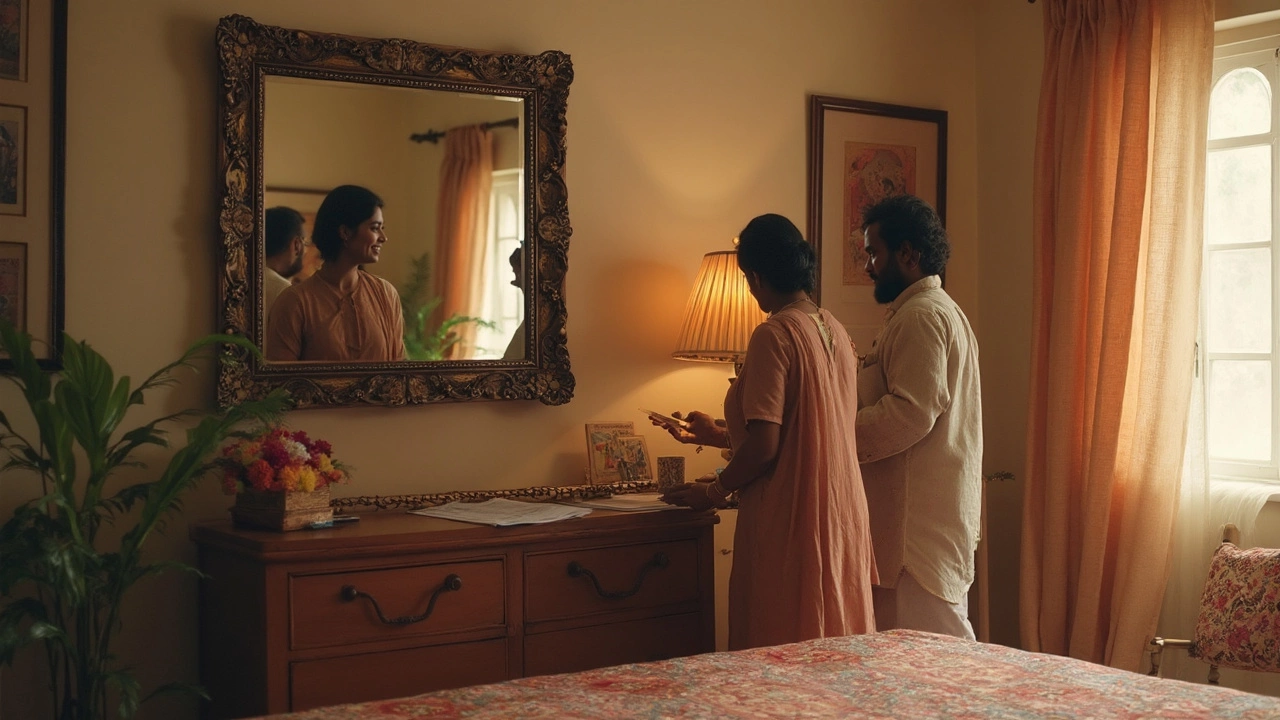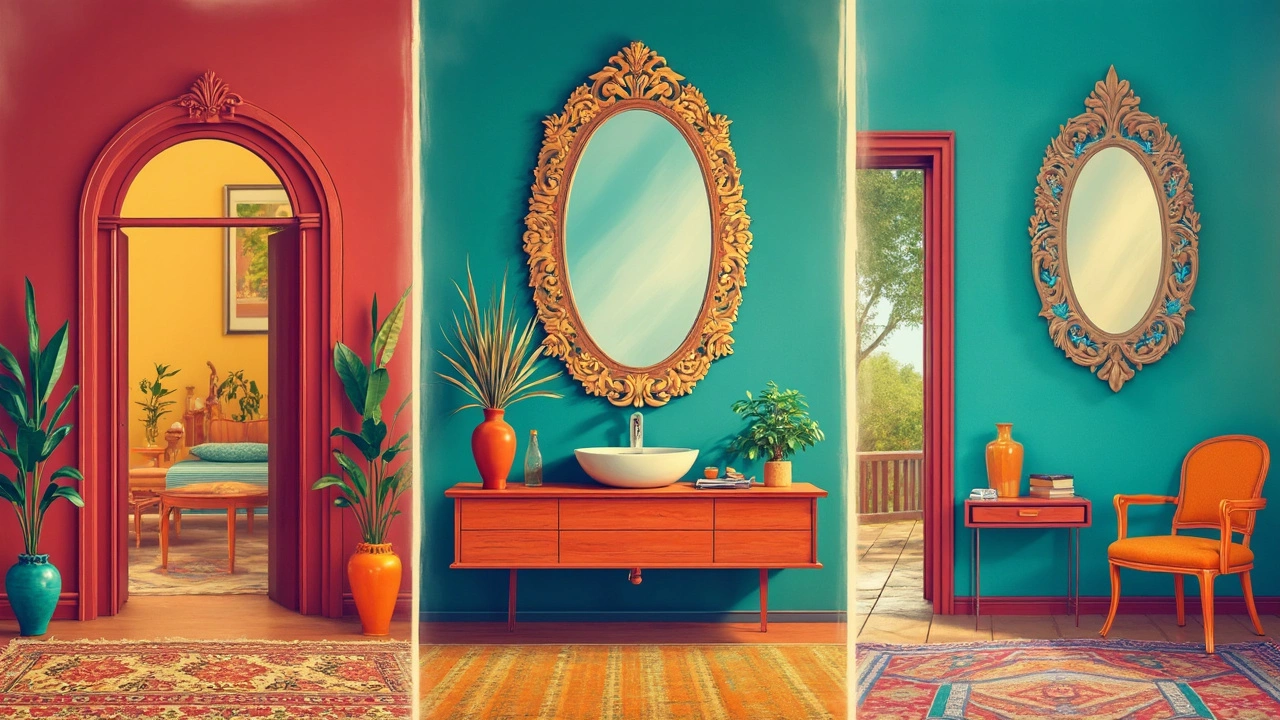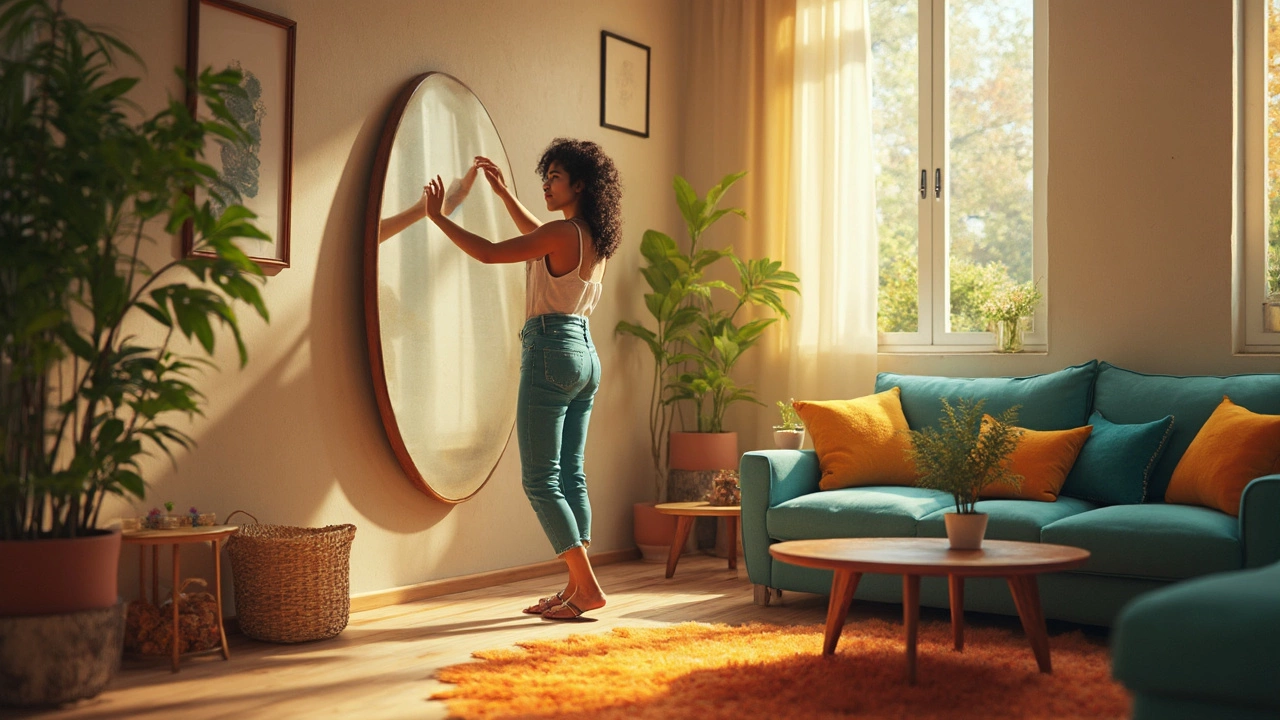Picking out a mirror feels way trickier than it should. Too small, and it looks lost on the wall. Too big, and suddenly your room feels like a dance studio. What’s the sweet spot? It all comes down to what you want your mirror to do—show off your outfit, bounce light, or just look stylish as heck.
Start by thinking about where you want your mirror. Is it going above a bathroom sink, on a dresser, or maybe leaning on the floor in your bedroom? The purpose really changes everything. For example, a bathroom mirror usually lines up with the width of the vanity (not wider!), while a decorative living room mirror can go bolder and act like art.
Here’s a quick fix: grab some painter's tape and outline where you’d hang your dream mirror. It gives you an instant preview of what’s too much and what’s barely-there. You’ll see how the size messes with furniture, outlets, and wall art—even before spending a dime.
It helps to know that designers often aim for mirrors that are about two-thirds to three-quarters the width of the furniture they’re above. No more squinting and hoping you guessed right at the store. These little ratios keep things balanced, no matter your style.
- How Mirror Size Impacts a Room
- Basic Rules for Choosing Mirror Size
- Finding the Right Size for Each Room
- Tricks for Making Small Spaces Feel Bigger
- Common Mistakes (and How to Avoid Them)
How Mirror Size Impacts a Room
The size of your mirror can totally change the feel of your space. When you go big, mirrors create the illusion of more room by reflecting light and surroundings. That’s why hotels and restaurants love huge mirrors—they make cramped spaces feel roomy and more inviting. On the flip side, a small mirror can look cute and tidy, but it might not bring much extra brightness or the sense of openness you get from larger mirrors.
Here’s something surprising: A floor mirror at least 60 inches tall can instantly add visual height to any room—even a tiny apartment. Meanwhile, a row of smaller mirrors just makes things look busier, not necessarily bigger.
Let’s look at a few quick size-and-effect facts:
| Mirror Size | Room Effect | Common Use |
|---|---|---|
| Oversized (48”+) | Adds drama, maximizes light, boosts spaciousness | Living room, entryway, leaning floor mirror |
| Medium (24”-47”) | Balances wall space, reflects areas but not whole rooms | Bedroom, above fireplaces or sinks |
| Small (<24”) | Decorative accent, does not increase light or space much | Gallery walls, bathrooms, entry catch-all spots |
If you’re hoping to make your place look bigger and brighter, bigger truly is better—within reason. Just make sure the mirror’s frame or edge doesn’t touch the wall or trim; you’ll want a little breathing room (about 4-6 inches of space) so it doesn’t look squished. Also keep in mind, if the mirror reflects clutter (like a pile of laundry), it actually doubles the mess. That’s definitely not the effect anyone’s after.
One more thing: mirrors hung across from a window kick the daylight around your room way better than standard lighting fixtures. A study by Lighting Research Center found well-placed mirrors can boost room brightness up to 30% during daylight hours. So, a large, well-placed mirror isn’t just for looks—it's a legit trick for better living. Still, the right mirror size is key for getting that magic effect, so don’t just pick whatever’s on sale.
Basic Rules for Choosing Mirror Size
There’s actually some hard-and-fast advice when it comes to picking the right mirror size. You don’t need to overthink it, but you do want your mirror to look right for the space and what it’s doing.
- Width Rules: If you’re hanging a mirror above furniture, like a sofa, console table, or bathroom vanity, keep its width between 2/3 and 3/4 of the piece below. So, for a 60-inch dresser, your mirror should be around 40-45 inches wide. This stops your mirror from looking either puny or massive.
- Eye Level: Hang the mirror so the center is at about 57-65 inches from the floor—around average eye height. This is the standard for art in galleries too. If your family is tall or short, adjust as needed.
- Single vs. Multiple Sinks: For a double-sink vanity, two separate mirrors almost always look neater than one giant piece. Give them a few inches of space from the edge of each sink.
- Proportion First: Don’t let mirrors cover more than two-thirds of the wall unless you’re going for the full-wall look, like a gym or yoga studio.
- Frame Matters: If your mirror has a thick decorative frame, account for that in your measurements. A bulky frame can make a mirror feel much larger in the space, even if the glass area isn’t huge.
Here’s a quick look at the most common mirror sizes and where they fit best:
| Mirror Size | Best Use | Placement Tip |
|---|---|---|
| 20"–30" | Accent, small bathrooms, entryways | Works well above a small sink/table |
| 30"–40" | Bathrooms, dressers, mantels | Good mid-size choice for most bedrooms and living rooms |
| 40"–60" | Living rooms, dining rooms, accent walls | Makes an impact, fits large furniture |
| 60"+ | Full-length, leaning, statement pieces | Place on the floor or big, open walls |
Remember, a mirror doesn’t have to be a perfect rectangle. Rounds and ovals often look best a bit smaller than their rectangle cousins in the same spot because they’ll naturally read as “softer” on the wall.

Finding the Right Size for Each Room
The right mirror size totally depends on which room you're putting it in, plus what you actually want out of it. Let’s break it down room by room, so you never end up with a mirror that looks awkward or feels pointless.
Mirror size isn’t a one-size-fits-all deal. Here’s what to keep in mind for every spot in the house:
- Bathroom: For a classic look, your mirror should be slightly narrower than your vanity—think 2 to 4 inches shorter on either side. If your vanity is 36 inches wide, aim for a mirror between 28 and 32 inches wide. For shared sinks, consider getting two smaller mirrors instead of one giant one.
- Bedroom: Full-length mirrors need to be at least 48 inches tall if you want a head-to-toe view, but bigger always feels fancier. Wall mirrors over dressers look best at around two-thirds the width of the furniture below—so a 60-inch dresser gets a 40-inch-wide mirror.
- Living Room: If you’re using a mirror as a statement piece, go for big and bold—just make sure it isn’t wider than the furniture below (like a console or couch). Small mirrors can get lost on a big wall, so anchor them with art or shelves.
- Entryway: This is where most people check their hair before they rush out. A round or rectangle mirror that’s between 24 and 36 inches works in most narrow halls. If your space is open, don’t be afraid to go bigger.
- Dining Room: Mirrors here do more than reflect—they bounce light and energy. Horizontal shapes make a room feel wider, while big vertical mirrors can boost the sense of height in lower spaces.
Take a look at this quick guide for typical sizes by room and use case. These are averages, so there’s wiggle room—just don’t go smaller unless you have a very tight spot.
| Room | Common Mirror Size Range (inches) | Best Use |
|---|---|---|
| Bathroom Vanity | 28–36 W x 24–36 H | Standard single sink |
| Full-Length/Bedroom | 48–72 H x 18–36 W | Outfit checks, leaning against wall |
| Living Room | 30–48 diameter (round) or 24–60 W (rectangle) | Over a console or as a statement |
| Entryway | 24–36 diameter or width | Quick check before heading out |
| Dining Room | 36–60 W x 24–40 H | Makes space look bigger |
The best trick? Always go bigger if your wall can handle it. Most people regret mirrors that are too small, not too large. Measure your wall, don’t eyeball it. If you’re nervous about overpowering a space, tape up a paper template first—you’ll know right away if it feels right or just weird.
Tricks for Making Small Spaces Feel Bigger
If you’re crammed in a tiny space, a mirror size can totally change the vibe. The right mirror turns a shoebox of a room into something way more open, and it’s honestly one of the cheapest ways to fake square footage.
Place your mirror directly across from a window if you’ve got one. This doesn’t just look cool – it actually bounces more natural light around, making everything look brighter and bigger. If your room is windowless, put a big mirror behind a lamp or other light source. You might be surprised by how much it seems to double the light in the room.
- Go tall: Use a full-length mirror, even if you don’t have space for it on the floor. You can wall-mount it vertically. This stretches the eye upward and adds height to the room.
- Skip thick, bulky frames in small spaces. Thin or frameless mirrors blend into the wall and feel less cluttered.
- Group a few smaller mirrors together instead of one large one if the wall’s too tiny. This makes a statement and spreads the light around.
Leaning a mirror against a wall instead of hanging it can also soften the edges of a room and shake up the look. Designers often use oversized leaners in narrow hallways or cramped bedrooms for that reason.
You’ll notice that mirrors work best when you keep everything around them simple — less furniture, fewer colors. Let the mirror do most of the heavy lifting. If you’re tight on space, avoid cluttering the area around the mirror with shelves or hooks.
One quick tip: always clean your mirror well. Smudgy glass actually makes rooms feel less open. Sparkly clean mirrors maximize that whole ‘wow, this room is huge’ effect.

Common Mistakes (and How to Avoid Them)
It’s way too easy to get things wrong with mirror size. Most people either pick a mirror that’s way too tiny for the space or end up buying something so huge, it takes over the whole wall. Here's why that happens and how to dodge typical slip-ups.
- Going Too Small: Ever seen a little mirror above a big couch? It kind of looks like it belongs in a dollhouse. A good rule is your mirror should be about two-thirds to three-quarters the width of the furniture beneath it. That’s what most pros stick to because it keeps everything balanced.
- Wrong Height Placement: Hanging your mirror too high or too low throws off the whole vibe. Most mirrors should be hung at about eye level (around 60 inches from the floor to the middle of the mirror). Your face shouldn’t get chopped off every time you check your reflection.
- Forgetting the Room’s Purpose: Don't stick a decorative mirror where you need a practical one. For example, a tiny round mirror in the bathroom might look pretty, but you’ll regret it when you’re trying to shave or do your makeup.
- Ignoring Frame Size: Some mirrors have chunky frames, which shrink the actual reflection area. Always factor in the frame width, not just the total size.
- Too Much Reflection: Mirrors bounce light and energy, sure, but facing one directly toward a busy spot (like a cluttered desk or your unmade bed) just doubles the mess. It’s no help if you’re trying to keep things looking calm.
One expert tip comes right from interior stylist Emily Henderson. She says,
"The most common mistake is not considering what the mirror will reflect. You want it to bounce light and show off your best angles, not highlight the ugly corner that’s full of cords and clutter."
If you start with purpose, measure twice, keep things at eye level, and check what the mirror’s actually showing you, you’ll avoid those classic mistakes. Test with paper cutouts or painter’s tape before drilling holes—yes, it actually saves tons of regret later.
